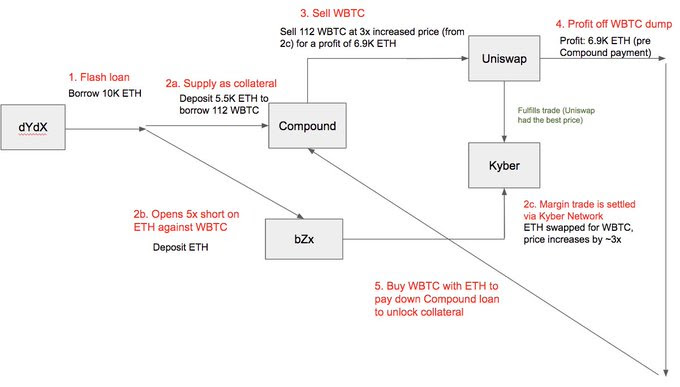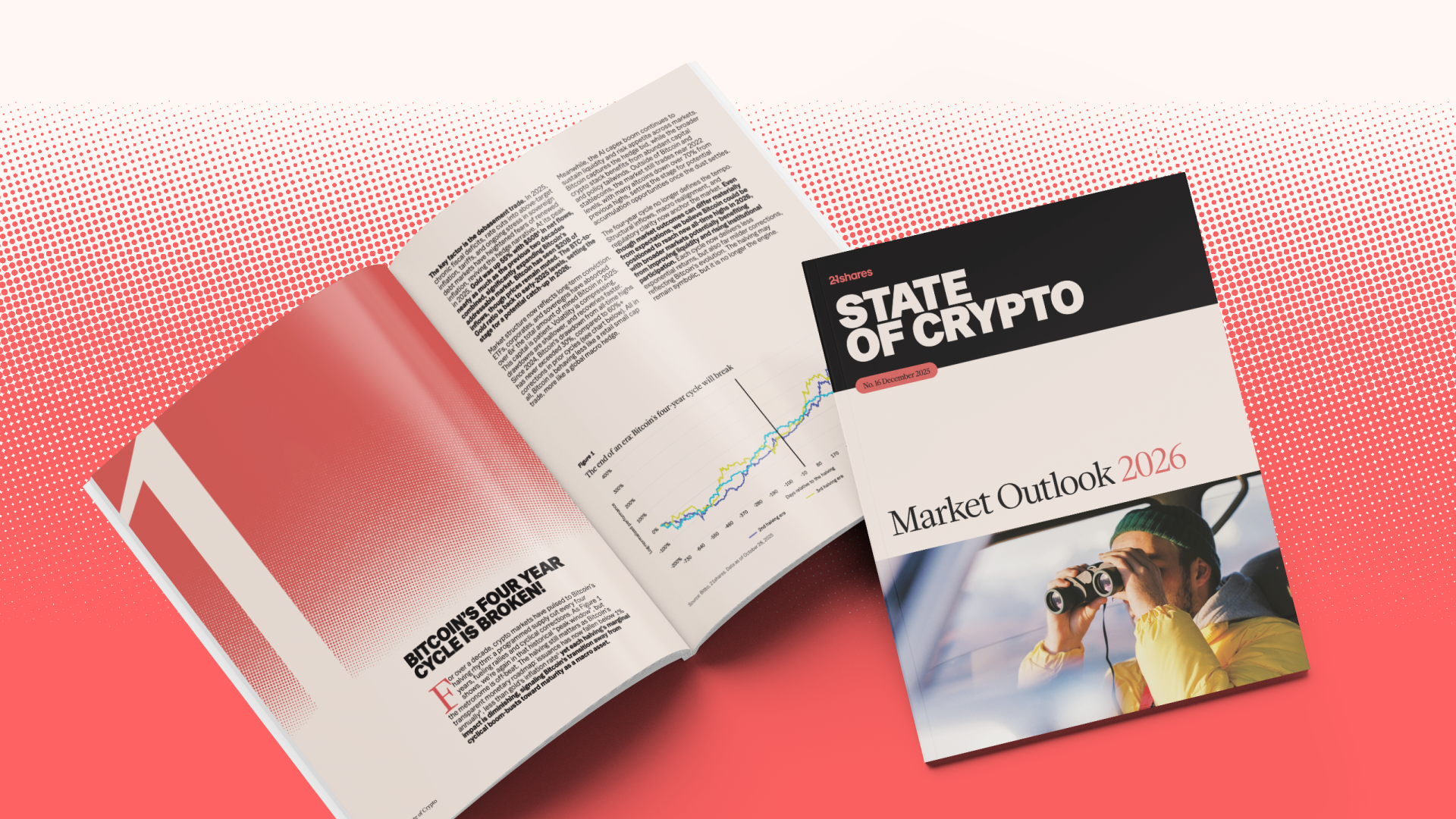Crypto Market Weekly Update: FCoin Collapse & bZx Hacks
.jpg)


Market Outlook
The last week has been difficult for the crypto asset industry, in particular Bitcoin, Bitcoin Cash, and Litecoin. In this case, the week began with a large amount of positive momentum from the week before but the news of FCoin's insolvency and of a Decentralized Finance application (DeFi), bZx, being manipulated. The top five crypto assets performed as follows: BTC (-5.74%), ETH (12.19%), XRP (1.63%), BCH (-11.65%), and LTC (-4.95%).
The average on-chain transaction volume for the top-five crypto assets is as follows: BTC ($2.46B), ETH ($553M), XRP ($248M), BCH ($321M), and LTC ($48.3M). On average the total daily on-chain transaction volume number was up from $3.09B to $3.63B — driven by noticeable increases in on-chain volume from XRP and ETH.
Podcast - Understanding Crypto Market Microstructure (w/ CoinDesk Head of Research, Noelle Acheson)
In the latest episode of the Amun State of Crypto, Ophelia (Amun's co-founder and president) and Lanre (Amun's researcher) discuss crypto's market microstructure with Noelle Acheson, CoinDesk's Head of Research. The group discusses the differences in the market microstructure between the crypto asset industry and traditional capital markets. The guests drew from their experience within capital markets to understand the intricacies of the crypto market.
Listen to the full episode on Spotify, Apple Podcasts, or Megaphone. This episode was co-hosted with CoinDesk and is available on there also.
News - Crypto Exchange FCoin Insolvent After Revealing Up to $130M Bitcoin Shortfall | CoinDesk
What Happened?
FCoin, a crypto exchange that adopted the controversial "trans-fee mining" model, has paused trading and withdrawal as it reveals a shortage of crypto assets worth up to $130 million.
Zhang Jian, the former Huobi CTO who launched FCoin in May 2018, wrote a lengthy post (the English translation is available here on Reddit) on Monday, saying the exchange is now unable to process users' withdrawal demands as its asset reserve has fallen short of its liability – and the gap is estimated to be about 7,000 to 13,000 bitcoin.
In summary, he said the issue came from internal system errors that have – for a long period of time – credited users with more transaction-based mining rewards than they should have received. As the company failed to spot this soon enough to remedy the situation, the snowball has grown even larger since the beginning of 2019.
Why Does It Matter?
Given the lack of information provided by Zhang about the exact reasons for the insolvency, it is extremely easy for one to not digest the explanation given in the best faith — especially given the industry's history of exchanges becoming insolvent under dubious circumstances. It remains to be seen what the outcome of the insolvency are likely to be but we can imagine the reported loss is likely to be shared equally among users.
One likely long-term consequence of this hack and the others over the last few years is that, whether due to consumer demands or regulatory intervention, exchanges are likely to be forced to post Proofs of Reserve — data which proves their solvency. This would be a necessary step to ensure that exchanges aren't able to take advantage of users by not holding full reserves; certain exchanges such as Kraken have already begun using Proofs of Reserve in order to instil user confidence.
Learn more here.
News - Decentralized Finance Application bZx Attacked Twice in One Week, Around $940,000 Lost | The Block
What Happened?
Decentralized finance (DeFi) lending protocol bZx has just been exploited - again. The estimated loss is 2,388 ether (ETH) this time, i.e. nearly $645,000. “This attack appears to be an oracle manipulation attack,” said bZx co-founder Kyle Kistner in the firm’s official Telegram channel. Market observers are referring to this transaction as suspicious for the latest attack.
“We can neutralize this like we did last time,” said Kistner. Just earlier today, bZx published a post-mortem of their initial attack, saying that 1,193 ETH, currently worth around $298,000, were lost. In light of the latest suspicious transaction, bZx has again paused its protocol. The transaction is said to have occurred using flash loans and trading on Synthetix. "It does not impact the Synthetix system though it did involve sUSD," bZx tweeted today.
Why Does It Matter?
The diagram (Source: Jason Choi) below shows the steps that the manipulator used to carry out. the attack which made the use of several DeFi platforms including dYdX, bZx, Compound, Uniswap, and Kyber. Key to the manipulation was the use of a "flash loan" which allowed the manipulator to carry out the whole process within a single transaction on the Ethereum blockchain. Flash loans are unique as they have no collateralization requirements, therefore the attacker was able to pull off the scheme without any upfront capital.

The fact that an attacker was able to pull off similar attacks twice does not look good for either bZx or the DeFi ecosystem as a whole. This has been reflected in the "Total Value Locked" data for bZx where the USD value of collateral locked in the platform fell from $19.4M to $12.6M yesterday, as we show in the graph below. We think that such an issue is not an existential risk to the DeFi ecosystem on Ethereum but it does show that the ecosystem has serious issues with manipulation and security risk handling where there currently does not exist an operational precedent. Both bZx and a third-party analyst have done deep-dive post mortems into the event.
Learn more here.
News - Crypto Giant Binance Launches Cloud Service in Revenue Shift — Bloomberg
What Happened?
Binance Holdings Ltd., one of the world’s largest cryptocurrency-trading platforms, has made its first foray into business services by lending its technology and liquidity to those who want to start their own exchanges.
The Malta-based crypto behemoth announced its cloud operation to help business clients and partners set up crypto exchanges using Binance’s tech infrastructure, ranging from matching engines to risk controls and data security systems, according to a company statement. Binance Cloud will overtake the company’s main exchange to become its biggest source of revenue in five years, co-founder and CEO “CZ” Zhao Changpeng estimates.
Why Does It Matter?
The original value proposition of crypto assets was their ability to reduce the marginal cost of engaging in finance and creating financial instruments. We can view Binance's efforts to massively reduce the fixed costs involved in launching an exchange as a further expression of that. Cloud computing has been one of the most profitable areas of technology over the last five years due to platforms like AWS, Azure, and Google Cloud. It remains to be seen whether a crypto-focused cloud vertical could generate similar margins in the long-term.
One possibility is that Binance's cloud solution is used mainly to provide bespoke exchange offerings in particularly underserved geographies (i.e. Sub-Saharan Africa or the Middle East) or segments of the industry (i.e. prediction markets) which would benefit from a more unbundled exchange ecosystem. The chart below shows data from Gartner of the growth in the cloud computing industry from 2009 to 2022, with the data points for 2019-2022 using Gartner's predictions. Such rapid growth of the cloud computing industry has been the impetus behind many businesses attempting to incorporate cloud computing offerings (such as for software development, for example) to some success, it remains to be seen whether the strategy will work for Binance.
Disclaimer: Note that Amun launched an ETP in collaboration with Binance — the Amun Binance BNB ETP (ABNB).
Disclaimer
The information provided does not constitute a prospectus or other offering material and does not contain or constitute an offer to sell or a solicitation of any offer to buy securities in any jurisdiction.
Some of the information published herein may contain forward-looking statements. Readers are cautioned that any such forward-looking statements are not guarantees of future performance and involve risks and uncertainties and that actual results may differ materially from those in the forward-looking statements as a result of various factors.
The information contained herein may not be considered as economic, legal, tax or other advice and users are cautioned to base investment decisions or other decisions solely on the content hereof.

.jpg)














